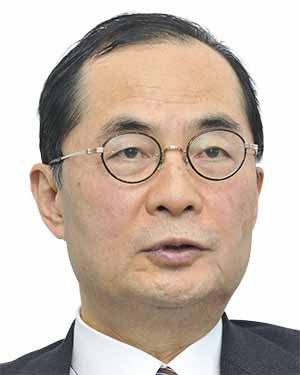20:40 JST, February 2, 2024
Though we’ve ushered in a New Year, it seems we’ve not swept away the sense of stagnation in Japan.
There is a piece of calligraphy on display at Rissho University, where I served as president, that expresses a wish for “the East and the West [to have] a New Year full of peace and happiness like one family.” The message is dated Jan. 1, 1960, and was written during the Cold War by the university’s then President Tanzan Ishibashi, whose other jobs included journalist, economist and postwar prime minister.
More than ever, I wish such peace and happiness would prevail. In reality, however, senseless slaughter is taking place day after day around the world, and we are far from having a New Year full of family peace and happiness.
Japan is different from those countries and regions that are in the midst of prolonged wars or conflicts. Why then does Japan remain stagnant? The reasons are perfectly clear. They have been discussed for a long time now as challenges faced by this country.
The biggest issue is the country’s shrinking population. Many measures to check the demographic decline have already been taken, to no avail. In its 2023 population projection for Japan, the National Institute of Population and Social Security Research said the country’s population, which stood at 126 million in 2020, would likely fall below 90 million in 2070, with people age 65 or over — the elderly cohort — to account for 39% of the total.
This projection assumed that the total fertility rate, or the average number of children expected to be born per woman in a lifetime, would be 1.36 in 2070. However, it should be noted that projections of this kind have always been wrong. We should expect the reality to be even worse.
In fact, the number of babies born in Japan in 2022 came to about 770,000, dropping below 800,000 for the first time and marking the lowest figure since records began in 1899. The number is expected to contract further in 2023 to set yet another record low.
The concurrent issues of the declining birth rate and the rising number of elderly people will increase the need for old-age pensions, medical services and long-term care. How can social security be sustained in a “super aging society”? This is a problem common among developed countries.
A survey conducted in 2020 by Nihon Yoron Chosakai, an organization for public opinion research, found that only 1% of respondents “feel at ease” about the social security system. Overall positive responses, which include those who feel “at ease to a certain extent,” came to a mere 16%, according to the organization. More than 80% said they either “feel uneasy” or “don’t feel enough at ease.”
Young people are afraid that they will not receive a large enough pension when they are older. The elderly, for their part, are worried because they sense their health declining but cannot be sure how much money they will need for medical and long-term care.
But our troubles are not limited to the falling birth rate and the aging population. The COVID-19 pandemic and the Noto Peninsula Earthquake, which have left many dead, remind us of the horrors of infectious disease and natural disasters. Defense-related debates have also grown more pressing since Russia’s aggression against Ukraine.
A mathematical fact
These issues cannot be solved by individuals. Society as a whole must tackle them. This means the public must pay the taxes needed to finance central and local governments as well as social insurance premiums.
Distrust in politics has risen since late last year amid a scandal involving possible violations of the Political Funds Control Law. As a result, some people may say any increase in the public tax burden is out of the question. Even a leading member of the ruling Liberal Democratic Party’s Research Commission on the Tax System has said something to this effect.
Nonetheless, we must bear our fair share of the financial burden, so that we may resolve the issues that plague Japan and that create this sense of stagnation. This is an inescapable mathematical fact.
Understandably, people want to spend their hard-earned money on themselves and their family. But that does not mean that they shun all other demands made on them. This was clearly illustrated in August 2023 when the National Museum of Nature and Science in Tokyo ran an online crowdfunding campaign.
The museum launched the campaign with a goal of raising ¥100 million to cover a shortfall in its funds for preserving specimens. Just about nine hours after the campaign started, the target was met. During the scheduled fundraising period, which ran into November, 57,000 people donated ¥920 million.
If people just want to see dinosaur fossils or unique specimens at a museum, they only need to pay an admission fee. But in the crowdfunding campaign, many people stepped up, donating money to the museum from a shared sense of crisis that “treasures of the Earth” that should be passed down to their children and grandchildren could be lost. In other words, they gave money willingly — no one forced them to donate — because they could imagine clearly and concretely how they would contribute to the future.
Regrettably, the public has little interest in paying what’s needed to resolve the host of issues facing Japan’s economy. Macro issues are far more complicated than micro ones such as a possible loss of “treasures of the Earth.” That is why people cannot picture clearly how taxes and premiums will help resolve these issues.
Take the social security system, for example. Though we are familiar with pensions and medical services, the ¥134 trillion paid out in a year for social security benefits is beyond imagining, making it difficult for us to wrap our heads around the figure.
And the same goes for social security reforms. The system is so intricate that many people can hardly understand what’s wrong with it in the first place.
Japan’s pension system has a so-called macroeconomic slide mechanism to ensure there are resources to pay future generations’ pensions, and to curb social security costs swollen by an aging population. The country’s old-age pensions are expected to be trimmed to reflect the actual size of the Japanese economy. I wonder how many people have even heard of the macroeconomic slide mechanism.
The country’s medical and long-term care systems have no macroeconomic slide mechanism, a fact that has let benefits under the systems rise at a pace detached from economic reality.
Social insurance premiums in Japan cover only 60% of pension, medical and long-term care benefits. The remaining 40% must be covered by tax revenues of the central and local governments. However, as they are chronically short on such revenue, they have relied on deficit financing by issuing government bonds, putting the issue off year after year. Restoring fiscal soundness would mean closing a massive gap in the social security system, like plugging a huge hole in the bottom of a ship’s hull.
The government reviews the social security system almost every year. In late December, when it compiled a draft budget for fiscal 2024, one of the centerpieces of the budget was a revision of medical fees, including a 0.975% reduction in drug prices, which did not include raw material costs, and a 0.88% increase in “core” fees, which cover personnel costs for doctors and nurses.
This kind of reworking cannot be called fundamental reform. In medical services, reforms should proceed with two key focuses: first, on how hospital and clinics can efficiently provide medical services, and second, on how the medical insurance system should be redesigned. As both areas have a myriad of problems, we’ll need to start from scratch.
The government recently decided to earmark ¥3.6 trillion per year in its budgets until fiscal 2026 to deliver what Prime Minister Fumio Kishida emphatically declares to be “a different dimension of policies for children and child-rearing.” Measures to combat the low birth rate will likely take not just two or three years but an indefinitely long time. This means the government should have a permanent source of funding. But what has emerged — an annual allocation of ¥3.6 trillion — is a stopgap measure that relies on medical insurance premiums and savings from other budget items.
The government now should give a clear and simple explanation of the state of Japan’s social security system and the problems that have to be redressed. Moreover, it should come up with a solid policy proposal and get the public on board with increased taxes and premiums.
Once we have a clear vision of the future of Japan, I am sure that much of the public will agree to shoulder their share of the increased financial burden.

Hiroshi Yoshikawa
Hiroshi Yoshikawa is a professor emeritus at the University of Tokyo. He has served as the chair of the Fiscal System Council, an advisory panel to the finance minister. He is the author of “Reconstruction of Macroeconomics: Methods of Statistical Physics, and Keynes’ Principle of Effective Demand.”
The original Japanese article appeared in the Jan. 28 issue of The Yomiuri Shimbun.
"Editorial & Columns" POPULAR ARTICLE
-

Violations of Subcontract Law: Major Automakers Must Eliminate Old Practices
-

Local Governments’ Tax Revenues: Devise Ways to Correct Imbalances in Tax Sources
-

5 Japanese Business Dinner Mistakes to Avoid — and What They Taught Me About Business in Japan
-

Heavy Rains in Asia: Support for Victims, Flood-Control Measures Urgently Needed
-

Rice Coupons: A Misguided Approach to Countering Rising Prices
JN ACCESS RANKING
-

Tokyo Economic Security Forum to Hold Inaugural Meeting Amid Tense Global Environment
-

Keidanren Chairman Yoshinobu Tsutsui Visits Kashiwazaki-Kariwa Nuclear Power Plant; Inspects New Emergency Safety System
-

Imports of Rare Earths from China Facing Delays, May Be Caused by Deterioration of Japan-China Relations
-

University of Tokyo Professor Discusses Japanese Economic Security in Interview Ahead of Forum
-

Japan Pulls out of Vietnam Nuclear Project, Complicating Hanoi’s Power Plans


























